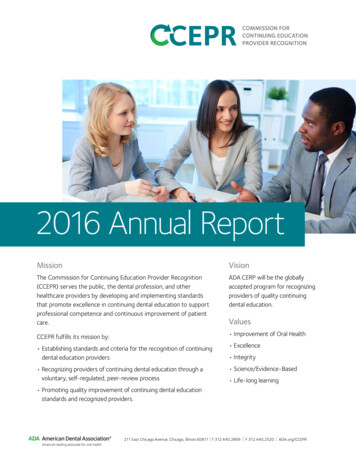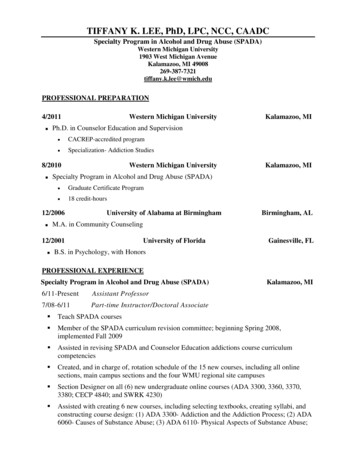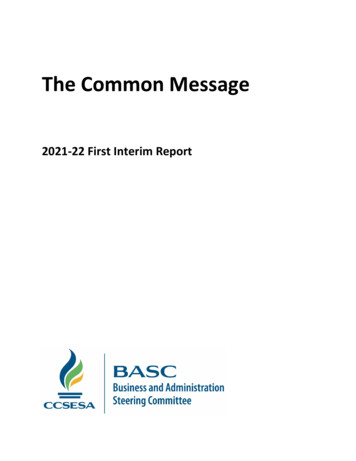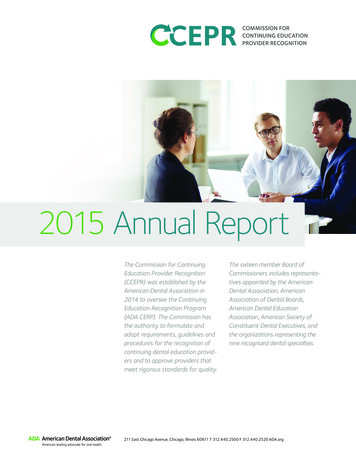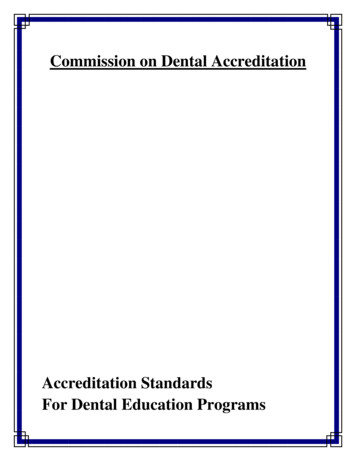
Transcription
Commission on Dental AccreditationAccreditation StandardsFor Dental Education Programs
Accreditation Standards forDental Education ProgramsCommission on Dental AccreditationAmerican Dental Association211 East Chicago AvenueChicago, Illinois 60611-2678(312) 440-4653www.ada.orgDocument Revision HistoryDateItemActionAugust 6, 2010Accreditation Standards for Dental Education ProgramsAdoptedFebruary 3, 2012Revision to Standard 2-23 eApprovedJuly 1, 2013Accreditation Standards for Dental Education ProgramsImplementedJuly 1, 2013Revision to Standard 2-23 eImplementedCopyright 2010Commission on Dental AccreditationAmerican Dental AssociationAll rights reserved. Reproduction is strictly prohibited without prior written permission.
Table of ContentsPAGEMission Statement of the Commission on Dental Accreditation . 2Accreditation Status Definitions . 3Introduction . 4Goals . 6Educational Environment . 9Definition of Terms Used in Accreditation Standards . 14Accreditation Standards for Dental Education Programs . 171-Institutional Effectiveness . 172-Educational Program. 202-12-32-92-102-112-152-172-202-21Instruction . 20Curriculum Management . 20Critical Thinking . 22Self-Assessment . 23Biomedical Sciences . 23Behavioral Sciences . 24Practice Management and Health Care Systems . 25Ethics and Professionalism . 25Clinical Sciences . 263-Faculty and Staff . 294-Educational Support Services . 304-14-54-64-74-9Admissions. 30Facilities and Resources . 30Student Services . 31Student Financial Aid . 31Health Services . 315-Patient Care Services . 336-Research Program . 35
Mission Statement of theCommission on Dental AccreditationThe Commission on Dental Accreditation serves the public by establishing, maintainingand applying standards that ensure the quality and continuous improvement of dental anddental-related education and reflect the evolving practice of dentistry. The scope of theCommission on Dental Accreditation encompasses dental, advanced dental and allieddental education programs.Commission on Dental AccreditationRevised: January 30, 2001DEP Standards-2-
Accreditation Status DefinitionsPrograms Which Are Fully OperationalAPPROVAL (without reporting requirements): An accreditation classification granted to aneducation program indicating that the program achieves or exceeds the basic requirements foraccreditation.APPROVAL (with reporting requirements): An accreditation classification granted to aneducational program indicating that specific deficiencies or weaknesses exist in one or moreareas of the program. Evidence of compliance with the cited standards must be demonstratedwithin 18 months if the program is between one and two years in length or two years if theprogram is at least two years in length. If the deficiencies are not corrected within the specifiedtime period, accreditation will be withdrawn, unless the Commission extends the period forachieving compliance for good cause.Programs Which Are Not Fully OperationalThe accreditation classification granted by the Commission on Dental Accreditation to programswhich are not fully operational is “Initial Accreditation.”Initial Accreditation: Initial Accreditation is the accreditation classification granted to anydental, advance dental or allied dental education program which is in the planning and earlystages of development or an intermediate stage of program implementation and not yet fullyoperational. This accreditation classification provides evidence to educational institutions,licensing bodies, government or other granting agencies that, at the time of initial evaluation(s),the developing education program has the potential for meeting the standards set forth in therequirements for an accredited educational program for the program for the specific occupationalarea. The classification “initial accreditation” is granted based upon one or more site evaluationvisit(s) and until the program is fully operational.DEP Standards-3-
IntroductionAccreditationAccreditation is a non-governmental, voluntary peer review process by which educationalinstitutions or programs may be granted public recognition for compliance with acceptedstandards of quality and performance. Specialized accrediting agencies exist to assess and verifyeducational quality in particular professions or occupations to ensure that individuals will bequalified to enter those disciplines. A specialized accrediting agency recognizes the course ofinstruction which comprises a unique set of skills and knowledge, develops the accreditationstandards by which such educational programs are evaluated, conducts evaluation of programs,and publishes a list of accredited programs that meet the national accreditation standards.Accreditation standards are developed in consultation with those affected by the standards whorepresent the broad communities of interest.The Commission on Dental AccreditationThe Commission on Dental accreditation is the specialized accrediting agency recognized by theUnited States Department of Education to accredit programs that provide basic preparation forlicensure or certification in dentistry and the related disciplines.StandardsDental education programs leading to the D.D.S. or D.M.D. degree must meet the standardsdelineated in this document to achieve and maintain accreditation.Standards 1 through 6 constitute The Accreditation Standards for Dental Education by which theCommission on Dental Accreditation and its consultants evaluate Dental Education Programs foraccreditation purposes. This entire document also serves as a program development guide forinstitutions that wish to establish new programs or improve existing programs. Many of thegoals related to the educational environment and the corresponding standards were influenced bythe work of the American Dental Education Association Commission on Change and Innovationand by best practices in accreditation from other health professions.The standards identify those aspects of program structure and operation that the Commissionregards as essential to program quality and achievement of program goals. They specify theminimum acceptable requirements for programs and provide guidance regarding alternative andpreferred methods of meeting standards.DEP Standards-4-
Although the standards are comprehensive and applicable to all institutions that offer dentaleducation programs, the Commission recognizes that methods of achieving standards may varyaccording to the mission, size, type and resources of sponsoring institutions. Innovation andexperimentation with alternative ways of providing required training are encouraged, assumingstandards are met and compliance can be demonstrated. The Commission recognizes theimportance of academic freedom, and an institution is allowed considerable flexibility instructuring its educational program so that it can meet the Standards. No curriculum hasenduring value, and a program will not be judged by conformity to a given type. TheCommission also recognizes that schools organize their faculties in a variety of ways.Instruction necessary to achieve the prescribed levels of knowledge and skill may be provided bythe educational unit(s) deemed most appropriate by each institution.The Commission has an obligation to the public, the profession and prospective students toassure that accredited Dental Education Programs provide an identifiable and characteristic coreof required education, training and experience.Format of the StandardsEach standard is numbered (e.g., 1-1, 1-2) and in bold print. Where appropriate, standards areaccompanied by statements of intent that explain the rationale, meaning and significance of thestandard. This format is intended to clarify the meaning and application of standards for boththose responsible for educational programs and those who evaluate these programs for theCommission.DEP Standards-5-
GoalsThe assessment of quality in educational programs is the foundation for the Standards. Inaddition to the emphasis on quality education, the Accreditation Standards for Dental EducationPrograms are designed to meet the following goals:1.to protect the public welfare;2.to promote an educational environment that fosters innovation and continuousimprovement;3.to guide institutions in developing their academic programs;4.to guide site visit teams in making judgments regarding the quality of the programand;5.to provide students with reasonable assurance that the program is meeting itsstated objectives.Specific objectives of the current version of the Standards include: streamlining the accreditation process by including only standards critical to theevaluation of the quality of the educational program; increasing the focus on competency statements in curriculum-related standards;and emphasizing an educational environment and goals that foster critical thinkingand prepare graduates to be life-long learners.To sharpen its focus on the quality of dental education, the Commission on Dental Accreditationincludes standards related to institutional effectiveness. Standard 1, “Institutional Effectiveness,”guides the self-study and preparation for the site visit away from a periodic approach byencouraging establishment of internal planning and assessment that is ongoing and continuous.Dental education programs are expected to demonstrate that planning and assessment areimplemented at all levels of the academic and administrative enterprise. The Standards focus,where necessary, on institutional resources and processes, but primarily on the results of thoseprocesses and the use of those results for institutional improvement.DEP Standards-6-
The following steps comprise a recommended approach to an assessment process designed tomeasure the quality and effectiveness of programs and units with educational, patient care,research and services missions. The assessment process should include:1.2.3.4.5.6.establishing a clearly defined purpose/mission appropriate to dental education,patient care, research and service;formulating goals consistent with the purpose/mission;designing and implementing outcomes measures to determine the degree ofachievement or progress toward stated goals;acquiring feedback from internal and external groups to interpret the results anddevelop recommendations for improvement (viz., using a broad-based effort forprogram/unit assessment);using the recommendations to improve the programs and units; andre-evaluating the program or unit purpose and goals in light of the outcomes ofthis assessment process.Implementation of this process will also enhance the credibility and accountability of educationalprograms.It is anticipated that the Accreditation Standards for Dental Education Programs will strengthenthe teaching, patient care, research and service missions of schools. These Standards arenational in scope and represent the minimum requirements expected for a dental educationprogram. However, the Commission encourages institutions to extend the scope of thecurriculum to include content and instruction beyond the scope of the minimum requirements,consistent with the institution’s own goals and objectives.The foundation of these Standards is a competency-based model of education through whichstudents acquire the level of competence needed to begin the unsupervised practice of generaldentistry. Competency is a complex set of capacities including knowledge, experience, criticalthinking, problem-solving, professionalism, personal integrity and procedural skills that arenecessary to begin the independent and unsupervised practice of general dentistry. Thesecomponents of competency become an integrated whole during the delivery of patient care.Professional competence is the habitual and judicious use of communication, knowledge, criticalappraisal, clinical reasoning, emotions, values and reflection in daily practice for the benefit ofthe individuals and communities served. Accordingly, learning experiences help students blendthe various dimensions of competency into an integrated performance for the benefit of thepatient, while the assessment process focuses on measuring the student’s overall capacity tofunction as an entry-level, beginning general dentist rather than measuring individual skills inisolation.DEP Standards-7-
In these Standards the competencies for general dentistry are described broadly. TheCommission expects each school to develop specific competency definitions and assessmentmethods in the context of the broad scope of general dental practice. These competencies mustbe reflective of an evidence-based definition of general dentistry. To assist dental schools indefining and implementing their competencies, the Commission strongly encourages thedevelopment of a formal liaison mechanism between the dental school and the practicing dentalcommunity.The objectives of the Commission are based on the premise that an institution providing a dentaleducational program will strive continually to enhance the standards and quality of bothscholarship and teaching. The Commission expects an educational institution offering such aprogram to conduct that program at a level consistent with the purposes and methods of highereducation and to have academic excellence as its primary goal.DEP Standards-8-
Educational EnvironmentAmong the factors that may influence predoctoral curricula are expectations of the parentinstitution, standing or emerging scientific evidence, new research foci, interfaces with specialtyor other dental-related education programs, approaches to clinical education, and pedagogicalphilosophies and practices. In addition, the demographics of our society are changing, and theeducational environment must reflect those changes. People are living longer with morecomplex health issues, and the dental profession will routinely be expected to provide care forthese individuals. Each dental school must also have policies and practices to achieve anappropriate level of diversity among its students, faculty and staff. While diversity of curriculais a strength of dental education, the core principles below promote an environment conducive tochange, innovation, and continuous improvement in educational programs. Application of theseprinciples throughout the dental education program is essential to achieving quality.Comprehensive, Patient-Centered CareThe Standards reconfirm and emphasize the importance of educational processes and goals forcomprehensive patient care and encourage patient-centered approaches in teaching and oralhealth care delivery. Administration, faculty, staff and students are expected to develop andimplement definitions, practices, operations and evaluation methods so that patient-centeredcomprehensive care is the norm.Institutional definitions and operations that support patient-centered care can have the followingcharacteristics or practices:1.2.3.4.ensure that patients’ preferences and their social, economic, emotional, physicaland cognitive circumstances are sensitively considered;teamwork and cost-effective use of well-trained allied dental personnel areemphasized;evaluations of practice patterns and the outcomes of care guide actions to improveboth the quality and efficiency of care delivery; andgeneral dentists serve as role models for students to help them learn appropriatetherapeutic strategies and how to refer patients who need advanced therapiesbeyond the scope of general dental practice.DEP Standards-9-
Critical ThinkingCritical thinking is foundational to teaching and deep learning in any subject. The componentsof critical thinking are: the application of logic and accepted intellectual standards to reasoning;the ability to access and evaluate evidence; the application of knowledge in clinical reasoning;and a disposition for inquiry that includes openness, self-assessment, curiosity, skepticism, anddialogue. In professional practice, critical thinking enables the dentist to recognize pertinentinformation, make appropriate decisions based on a deliberate and open-minded review of theavailable options, evaluate outcomes of diagnostic and therapeutic decisions, and assess his orher own performance. Accordingly, the dental educational program must develop students whoare able to: Identify problems and formulate questions clearly and precisely;Gather and assess relevant information, weighing it against extant knowledge andideas, to interpret information accurately and arrive at well-reasoned conclusions;Test emerging hypotheses against evidence, criteria, and standards;Show intellectual breadth by thinking with an open mind, recognizing andevaluating assumptions, implications, and consequences;Communicate effectively with others while reasoning through problems.Self-Directed LearningThe explosion of scientific knowledge makes it impossible for students to comprehend and retainall the information necessary for a lifetime of practice. Faculty must serve as role modelsdemonstrating that they understand and value scientific discovery and life-long learning in theirdaily interactions with students, patients and colleagues. Educational programs must depart fromteacher-centered and discipline-focused pedagogy to enable and support the students’ evolutionas independent learners actively engaged in their curricula using strategies that foster integratedapproaches to learning. Curricula must be contemporary, appropriately complex and mustencourage students to take responsibility for their learning by helping them learn how to learn.Humanistic EnvironmentDental schools are societies of learners, where graduates are prepared to join a learned and ascholarly society of oral health professionals. A humanistic pedagogy inculcates respect,tolerance, understanding, and concern for others and is fostered by mentoring, advising and smallgroup interaction. A dental school environment characterized by respectful professionalrelationships between and among faculty and students establishes a context for the developmentof interpersonal skills necessary for learning, for patient care, and for making meaningfulcontributions to the profession.DEP Standards-10-
Scientific Discovery and the Integration of KnowledgeThe interrelationship between the basic, behavioral, and clinical sciences is a conceptualcornerstone to clinical competence. Learning must occur in the context of real health careproblems rather than within singular content-specific disciplines. Learning objectives that cutacross traditional disciplines and correlate with the expected competencies of graduates enhancecurriculum design. Beyond the acquisition of scientific knowledge at a particular point in time,the capacity to think scientifically and to apply the scientific method is critical if students are toanalyze and solve oral health problems, understand research, and practice evidence-baseddentistry.Evidence-based CareEvidence-based dentistry (EBD) is an approach to oral health care that requires the judiciousintegration of systematic assessments of clinically relevant scientific evidence, relating to thepatient's oral and medical condition and history, with the dentist's clinical expertise and thepatient's treatment needs and preferences.1 EBD uses thorough, unbiased systematic reviews andcritical appraisal of the best available scientific evidence in combination with clinical and patientfactors to make informed decisions about appropriate health care for specific clinicalcircumstances. Curricular content and learning experiences must incorporate the principles ofevidence-based inquiry, and involve faculty who practice EBD and model critical appraisal forstudents during the process of patient care. As scholars, faculty contribute to the body ofevidence supporting oral health care strategies by conducting research and guiding students inlearning and practicing critical appraisal of research evidence.AssessmentDental education programs must conduct regular assessments of students’ learning throughouttheir educational experiences. Such assessment not only focuses on whether the student hasachieved the competencies necessary to advance professionally (summative assessment), but alsoassists learners in developing the knowledge, skills, attitudes, and values considered important attheir stage of learning (formative assessment). In an environment that emphasizes criticalthinking and humanistic values, it is essential for students to develop the capacity to self-assess.Self-assessment is indicative of the extent to which students take responsibility for their ownlearning. To improve curricula, assessment involves a dialogue between and among faculty,students, and administrators that is grounded in the scholarship of teaching and learning. Datafrom program outcomes, assessment of student learning, and feedback from students and facultycan be used in a process that actively engages both students and faculty.1American Dental Association, ents/evidencebased.asp.Accessed Oct 25, 2006.DEP Standards-11-
Application of TechnologyTechnology enables dental education programs to improve patient care, and to revolutionize allaspects of the curriculum, from didactic courses to clinical instruction. Contemporary dentaleducation programs regularly assess their use of technology and explore new applications oftechnological advances to enhance student learning and to assist faculty as facilitators of learningand designers of learning environments. Use of technology must include systems and processesto safeguard the quality of patient care and ensure the integrity of student performance.Technology has the potential to reduce expenses for teaching and learning and help to alleviateincreasing demands on faculty and student time. Use of technology in dental educationprograms can support learning in different ways, including self-directed, distance andasynchronous learning.Faculty DevelopmentFaculty development is a necessary condition for change and innovation in dental education.The environment of higher education is changing dramatically, and with it health professionseducation. Dental education programs can re-examine the relationship between what faculty doand how students learn to change from the sage authority who imparts information to a facilitatorof learning and designer of learning experiences that place students in positions to learn bydoing. Ongoing faculty development is a requirement to improve teaching and learning, to fostercurricular change, to enhance retention and job satisfaction of faculty, and to maintain the vitalityof academic dentistry as the wellspring of a learned profession.Collaboration with other Health Care ProfessionalsAccess to health care and changing demographics are driving a new vision of the health careworkforce. Dental curricula can change to develop a new type of dentist, providing opportunitiesearly in their educational experiences to engage allied colleagues and other health careprofessionals. Enhancing the public’s access to oral health care and the connection of oral healthto general health form a nexus that links oral health care providers to colleagues in other healthprofessions. Health care professionals educated to deliver patient-centered care as members ofan interdisciplinary team present a challenge for educational programs. Patient care by all teammembers will emphasize evidence-based practice, quality improvement approaches, theapplication of technology and emerging information, and outcomes assessment. Dentaleducation programs are to seek and take advantage of opportunities to educate dental schoolgraduates who will assume new roles in safeguarding, promoting, and caring for the health careneeds of the public.DEP Standards-12-
DiversityDiversity in education is essential to academic excellence. A significant amount of learningoccurs through informal interactions among individuals who are of different races, ethnicities,religions, and backgrounds; come from cities, rural areas and from various geographic regions;and have a wide variety of interests, talents, and perspectives. These interactions allow studentsto directly and indirectly learn from their differences, and to stimulate one another to reexamineeven their most deeply held assumptions about themselves and their world. Cultural competencecannot be effectively acquired in a relatively homogeneous environment. Programs must createan environment that ensures an in-depth exchange of ideas and beliefs across gender, racial,ethnic, cultural and socioeconomic lines.SummaryThese principles create an environmental framework intended to foster educational quality andinnovation in ways that are unique to the mission, strengths, and resources of each dental school.The Commission believes that implementation of the guidance incorporated in this documentwill ensure that dental education programs develop graduates who have the capacity for life-longand self-directed learning and are capable of providing evidence-based care to meet the needstheir patients and of society.DEP Standards-13-
Definition of Terms Used inAccreditation Standards forDental Education ProgramsCommunity-based experience: Refers to opportunities for dental students to provide patientcare in community-based clinics or private practices. Community-based experiences are notintended to be synonymous with community service activities where dental students might go toschools to teach preventive techniques or where dental students help build homes for needyfamilies.Comprehensive patient care: The system of patient care in which individual students orproviders, examine and evaluate patients; develop and prescribe a treatment plan; perform themajority of care required, including care in several disciplines of dentistry; refer patients torecognized dental specialists as appropriate; and assume responsibility for ensuring throughappropriate controls and monitoring that the patient has received total oral care.Competencies: Written statements describing the levels of knowledge, skills and valuesexpected of graduates.Competent: The levels of knowledge, skills and values required by the new graduates to beginindependent, unsupervised dental practice.Cultural competence: Having the ability to provide care to patients with diverse backgrounds,values, beliefs and behaviors, including tailoring delivery to meet patients’ social, cultural, andlinguistic needs. Cultural competence training includes the development of a skill set for moreeffective provider-patient communication and stresses the importance of providers’understanding the relationship between diversity of culture, values, beliefs, behavior andlanguage and the needs of patients.Dimensions of Diversity: The dimensions of diversity include: structural, curriculum andinstitutional climate.Structural: Structural diversity, also referred to as compositional diversity, focuses onthe numerical distribution of students, faculty and staff from diverse backgrounds in aprogram or institution.DEP Standards-14-
Curriculum: Curriculum diversity, also referred to as classroom diversity, covers boththe diversity-related curricular content that promote shared learning and the integration ofskills, insights, and experiences of diverse groups in all academic settings, includingdistance learning.Institutional Climate: Institutional climate, also referred to as interactional diversity,focuses on
Dental education programs leading to the D.D.S. or D.M.D. degree must meet the standards delineated in this document to achieve and maintain accreditation. Standards 1 through 6 constitute The Accreditation Standards for Dental Education by which the Commission on Dental Accreditation and its consultants evaluate Dental Education Programs for



